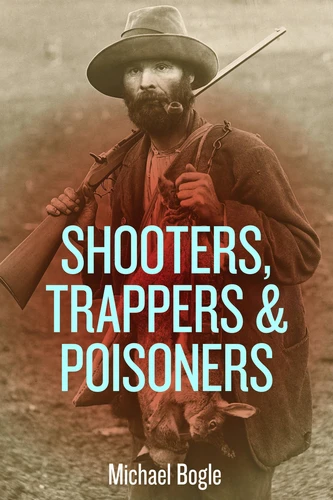Shooters, Trappers & Poisoners
Par :Formats :
Disponible dans votre compte client Decitre ou Furet du Nord dès validation de votre commande. Le format ePub est :
- Compatible avec une lecture sur My Vivlio (smartphone, tablette, ordinateur)
- Compatible avec une lecture sur liseuses Vivlio
- Pour les liseuses autres que Vivlio, vous devez utiliser le logiciel Adobe Digital Edition. Non compatible avec la lecture sur les liseuses Kindle, Remarkable et Sony
 , qui est-ce ?
, qui est-ce ?Notre partenaire de plateforme de lecture numérique où vous retrouverez l'ensemble de vos ebooks gratuitement
Pour en savoir plus sur nos ebooks, consultez notre aide en ligne ici
- FormatePub
- ISBN978-0-646-94275-9
- EAN9780646942759
- Date de parution29/10/2015
- Protection num.pas de protection
- Infos supplémentairesepub
- ÉditeurAuthor-Publisher
Résumé
Shooters, Trappers & Poisoners explores the rapidly receding world of Australian doggers and rabbiters as they wage war on two of Australia's most familiar feral animals, the dingo, its mixed-breed descendants and the feral rabbit. Beginning in the 19th century and continuing to the present, two paths emerge: one is the lucrative industry of selling animal pelts and carcasses (including the harvesting of koala and Tasmanian tiger skins); while the other is the practical requirements for eliminating wild dogs and rabbits.
Rabbiters and doggers are notorious for their unique and secretive tradecraft, such as the preparation of odiferous dog baits, the use of firearms, the setting of traps and the deployment of arcane poisons and gases. The book also explores the phenomenon of the Australian outlaw animal, the impact of germ warfare on rabbiting and the isolation of the outback. To frame this lively survey, Shooters, Trappers & Poisoners draws on oral histories, bush folklore, memoirs, scientific studies, contemporary newspaper accounts and 37 rarely seen photographs and illustrations.
Rabbiters and doggers are notorious for their unique and secretive tradecraft, such as the preparation of odiferous dog baits, the use of firearms, the setting of traps and the deployment of arcane poisons and gases. The book also explores the phenomenon of the Australian outlaw animal, the impact of germ warfare on rabbiting and the isolation of the outback. To frame this lively survey, Shooters, Trappers & Poisoners draws on oral histories, bush folklore, memoirs, scientific studies, contemporary newspaper accounts and 37 rarely seen photographs and illustrations.
Shooters, Trappers & Poisoners explores the rapidly receding world of Australian doggers and rabbiters as they wage war on two of Australia's most familiar feral animals, the dingo, its mixed-breed descendants and the feral rabbit. Beginning in the 19th century and continuing to the present, two paths emerge: one is the lucrative industry of selling animal pelts and carcasses (including the harvesting of koala and Tasmanian tiger skins); while the other is the practical requirements for eliminating wild dogs and rabbits.
Rabbiters and doggers are notorious for their unique and secretive tradecraft, such as the preparation of odiferous dog baits, the use of firearms, the setting of traps and the deployment of arcane poisons and gases. The book also explores the phenomenon of the Australian outlaw animal, the impact of germ warfare on rabbiting and the isolation of the outback. To frame this lively survey, Shooters, Trappers & Poisoners draws on oral histories, bush folklore, memoirs, scientific studies, contemporary newspaper accounts and 37 rarely seen photographs and illustrations.
Rabbiters and doggers are notorious for their unique and secretive tradecraft, such as the preparation of odiferous dog baits, the use of firearms, the setting of traps and the deployment of arcane poisons and gases. The book also explores the phenomenon of the Australian outlaw animal, the impact of germ warfare on rabbiting and the isolation of the outback. To frame this lively survey, Shooters, Trappers & Poisoners draws on oral histories, bush folklore, memoirs, scientific studies, contemporary newspaper accounts and 37 rarely seen photographs and illustrations.



